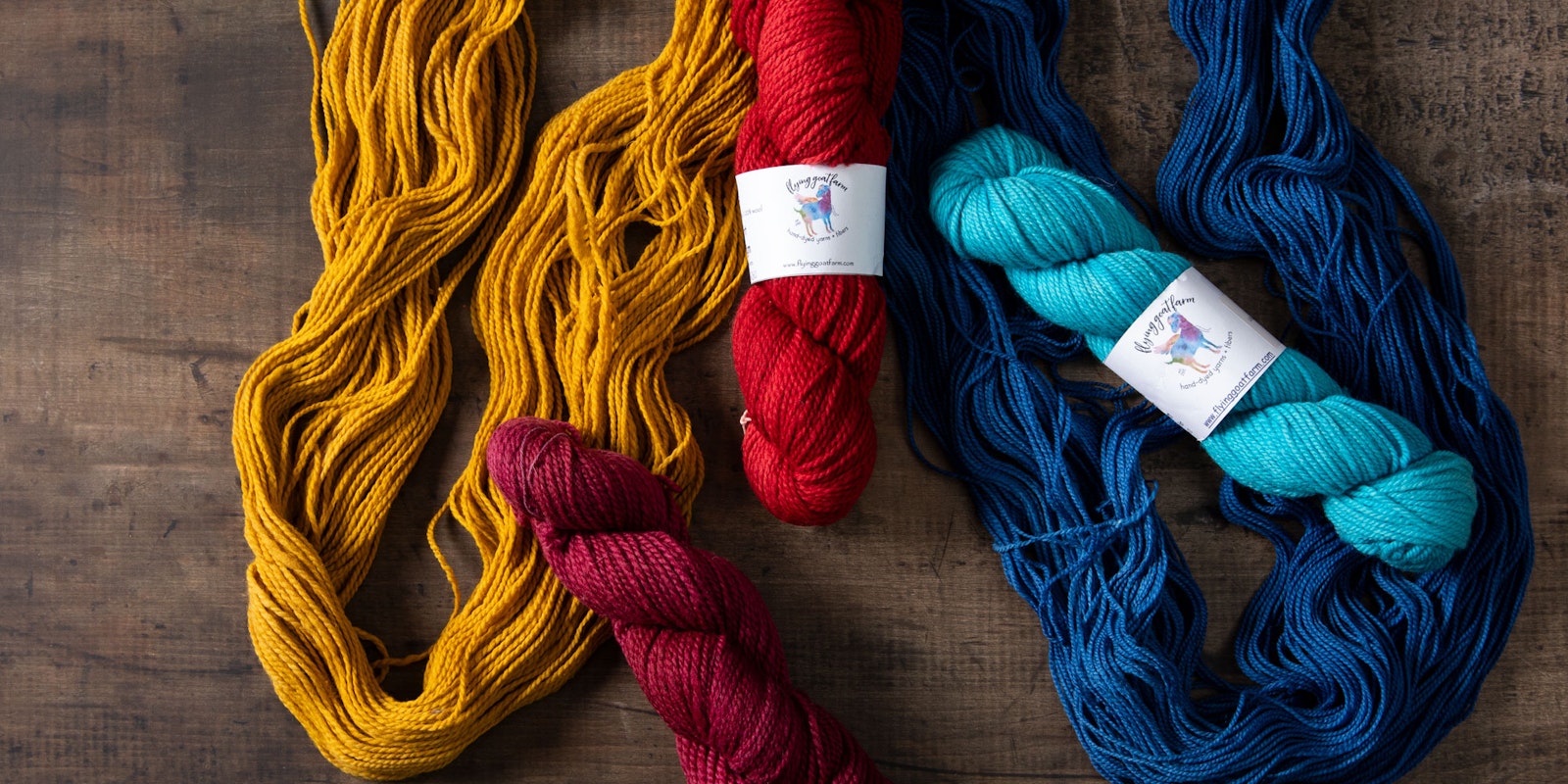I used to be a city girl. Growing up on the West Coast, I had never even touched a goat or sheep. But when we moved east to Maryland, I saw an opportunity to buy a farm and to live my dream of having a couple of Angora goats. I wanted the goats so I could spin their fiber, and because they are so cute!
I found very quickly that Angora goats grow an inch of fleece every month and that fiber from kids is best. Our herd grew from two to more than 50 posthaste as we purchased a buck to begin breeding Angora goats. Once we added Cormo sheep and began to breed lambs, I became so inundated with processing mohair and wool that I knew I would never catch up. That was when my quest to create great roving and yarn for other makers began.
Yarn Starts with the Fleece
 Lisa Check holds a Cormo lamb, who wears a clean coat. Photo courtesy of Flying Goat Farm
Lisa Check holds a Cormo lamb, who wears a clean coat. Photo courtesy of Flying Goat Farm
Yarn-making starts on shearing day. As animals are shorn, I am skirting, or taking out parts that are too dirty and removing sections that don’t match the rest of the fleece. I also sort while skirting, grouping well-matching fleeces that will give the best blended product.
Not every fleece is right for our yarn. Fleeces that are long and lustrous but coarser are best used in rugs, tapestries, and other household textiles. Fleeces that are fine and crimpy, such as Cormo, cashmere, or alpaca, are perfect for makers looking for a soft hand. Fibers in the middle are wonderful for durable outerwear garments. Even wool that is removed in skirting can be washed and used as stuffing for dolls, toys, and pillows. Some wool deemed too dirty or coarse to use in yarn can be made into fiber pellets and mulch for gardeners, dryer balls, cat toys, dish scrubbers, building insulation, and shoe liners. The list is limited only by imagination; there is a project for every fiber.
I chose to raise animals that would contribute to a wearable product. When designing our yarn, I use all these characteristics to make something unique that knitters, crocheters, and weavers will love. There is a balance among what I want as a yarn designer, how the fleeces like to be spun, and the intended use for the yarn. We now have fingering and sportweight yarn made from our Cormo.
The best yarn happens when the fiber, spin, and ply are in perfect balance. Over the years, I’ve worked with my mill to make a balanced 2-ply yarn that is beautiful to look at, soft enough to wear, and a pleasure to knit with. The mill’s skeins are close to the standard weights and either 4-ounce or 200-yard skeins.
Growing the (Yarn) Flock
A few years ago, I was able to widen our yarn line by partnering with local shepherds in my fibershed, some who had been discarding their wool. A nearby Polypay flock has consistent fleeces that are classed as medium wool. I knew that I could use the fiber in a nice outerwear yarn—and save that wool from going to the landfill.
I was able to obtain some nice fine Rambouillet fleece that we can have spun into a bulky weight. Those fleeces had been destined for a wool aggregator. During a wool pool, I recognized their value and was able to pay that shepherd a better price than he would have received for his really nice fleeces.
Incorporating these local fibers, our yarn bases now include all standard weights except lace and chunky yarns. Our yarns include wool, mohair, and blends of wool, mohair, and alpaca, as well as naturally colored wool yarns. These include naturally colored 100% wool, a 100% mohair in gray and brown, a 50% mohair/50% alpaca brown blend, and a silver blend of wool and mohair.
 Yarns from Flying Goat Farm include wool, mohair, alpaca, and blends in a variety of weights. Photo courtesy of Flying Goat Farm
Yarns from Flying Goat Farm include wool, mohair, alpaca, and blends in a variety of weights. Photo courtesy of Flying Goat Farm
Adding Color
When our yarn is back from the mill, the fun begins: dyeing. I work with two dye systems: low-impact acid dyes and natural dyes. Acid dyes are reliable; their colors are consistent. I know the best dye-to-yarn or -fiber ratio, so dye is not wasted. While low-impact acid dyes are less harmful to the environment than industrial dyes, they are still petroleum-based.
Natural dyes are less science and more art. Natural dyestuffs vary depending on the growing conditions, variety, and even the characteristics of water on any given day. The artistry begins when I add a little of “this and that” to achieve color. Using natural dyes that are grown or foraged locally can be ecologically beneficial.
Using farm yarn offers so many benefits. You have a connection with the land, animals, and farmers. You reduce your carbon footprint. I hope you find some farm yarn and make a local wardrobe part of your life.
 From left, gold, red, and maroon skeins of Polypay, naturally dyed; blue and teal skeins of Cormo, acid dyed. Photo by Matt Graves
From left, gold, red, and maroon skeins of Polypay, naturally dyed; blue and teal skeins of Cormo, acid dyed. Photo by Matt Graves
Lisa Check is the founder and owner of Flying Goat Farm in Frederick, Maryland. A spinner, weaver, knitter, and artisan dyer, she loves her sheep, Angora goats, and all their fine fiber. Lisa is a certified ASI Level II Wool Classer. She teaches spinning, weaving, and dyeing on her solar-powered farm. Follow her on Instagram @flyinggoatfarm or her website, flyinggoatfarm.com.

